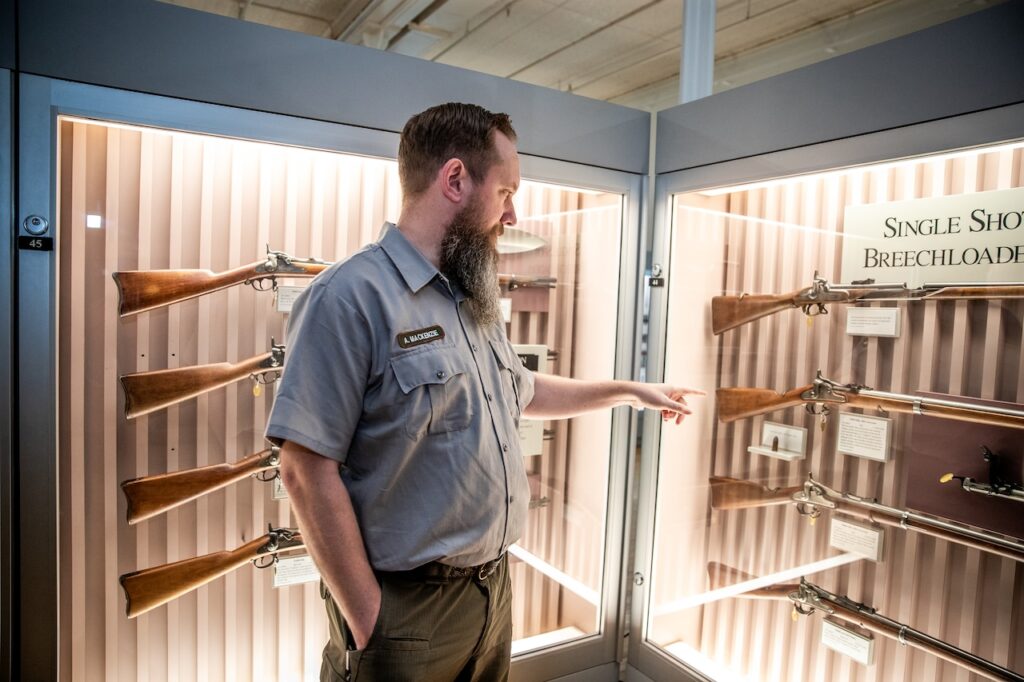SPRINGFIELD — The Springfield Armory Historic Site will host an exhibition of a stolen rifle that was recently recovered after its theft from the museum decades before.
That is, after the carbine is released from FBI custody, of course.
Made in the years after the Civil War when the Springfield Armory was developing breech-loading firearms, the carbine is one of four ever made.
“This has been a thing that … our predecessors have been searching for and keeping an eye out for,” said Alex MacKenzie, curator for the site. “This has been a long time coming.”
The FBI, the curator said, “had been in and out” of the armory over the years, at one point bringing the carbine there so MacKenzie could examine it. At that point, it was unclear if the gun was the armory’s missing carbine.
It had been a while since the agency’s last visit, so it was a surprise, MacKenzie said, when a reporter visited up last week, saying court filings showed the federal government seized the rifle.
Federal investigators said they reached the conclusion that the rifle was originally taken from the museum, even though someone obliterated its serial numbers and replaced parts to conceal its origin.
Assistant U.S. Attorney Carol E. Head notified a judge on April 28 that federal officials carried out a seizure warrant for the U.S. Springfield Model 1868 carbine. Sometimes called a trapdoor rifle, it is named after the hinged system designed to convert the muzzleloading rifles made during the Civil War into more modern breech-loading firearms.
For its four Model 1868 carbines, the Springfield Armory recycled and refitted parts from leftover rifles, shortening their barrels and prototyping the firearm for the U.S. Cavalry.

An image of a U.S. Springfield 1868 Model trapdoor carbine attached to affidavit filed in federal court. Authorities believe this rifle was taken from the Springfield Armory and is the property of the federal government. (FBI photo)submitted photo
The design never made it into production. When soldiers with the 7th Cavalry Regiment fought — and lost — the Battle of Little Bighorn in June 1876, for instance, they carried Model 1873 carbines, a more refined design.
The U.S. Cavalry “didn’t adopt anything officially until 1873, and that’s when they adopted the trapdoor,” MacKenzie said. “But it had evolved to the point where, by 1873, they were making all the parts from scratch. It was totally new production, but up until they adopted the trapdoor rifle and the trapdoor carbine, they were reusing parts all over the place.”
Among the changes: The 1868 carbine was a .50 caliber gun; the Model 1873 was slimmed down to a .45.
Of the four Model 1868s, one is believed to be in private hands. Another is in the collection of the Smithsonian, court records say.
Misfortune fell upon the two in possession of the Springfield Armory, though: One carbine — which is still in the museum’s collection — was damaged in a 1931 fire that marred a number of artifacts. Fire burned wooden stocks, and water used to quench the blaze seeped into the guns, causing internal damage, said MacKenzie.
“That one got burned pretty good,” MacKenzie said, which is why it is not on display.
As for the fourth Model 1868 carbine, museum staff discovered it missing when they conducted an inventory of the collection in 1985. They logged a report, which was eventually turned over to the FBI.
An FBI spokesperson declined to make an agent available for an interview, citing ongoing court proceedings.

Rifles at the Springfield Armory show the development of the trapdoor rifle, based on earlier models. (Douglas Hook / The Republican)Douglas Hook
MacKenzie said the museum went through a “vulnerable time” after it was designated a national historic landmark in 1974. At that time, it transitioned from being run by a nonprofit group to National Park Service oversight.
A “couple dozen” artifacts remain missing from the Springfield Armory Historic Site’s collection, he said.
“This is what, unfortunately, some museums go through,” said Kelly Fellner, superintendent of the site. “As a curator, you keep track of what you have and what’s not there, and then it’s law enforcement officials … the FBI is really looking and helping us recover lost and stolen items, just as they’re doing for other crimes.”
Over the years, the museum received tips about the carbine’s whereabouts, which they passed to law enforcement: In 1994, several people told the National Park Service that the gun was stolen and ended up in the possession of a gun collector, according to a court affidavit by FBI Special Agent Pasquale Morra. In 2015, MacKenzie heard the rifle was being sold at a gun show in Baltimore, Maryland.
A collector, unnamed in court documents, who purchased the carbine in 2021 at an auction for $5,000, allowed the FBI to examine the firearm.
After the carbine was examined by MacKenzie in Springfield and at the FBI laboratory in Quantico, Virginia, and with an electron microscope, Morra concluded: “Probable cause exists to believe that the (defendant’s) property is property of the United States government and was removed from the Springfield Armory’s collection … and therefore is subject to civil forfeiture.”
In the meantime, the carbine is in now in the hands of the FBI, according to MacKenzie. The civil court process is ongoing.
“We’ll certainly tell the story … when this thing comes back,” MacKenzie said.
When the museum received marksmanship medals recovered by the FBI in 2023, it held a ceremony attended by an FBI special agent and Assistant U.S. Attorney Head, who was involved in their recovery. As they spoke, the medals sat nearby, laid out in a display case under glass.


